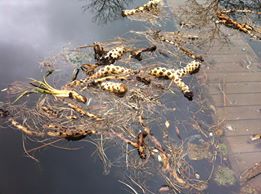Curiosities of this winter on Lake Scugog
This past winter started early and carried on late. It started cold and stayed cold until early to mid May. The lake froze to depths that were deeper than anyone seems to remember — up to 4.5 ft. When this happened, not only the water froze. The bottom muck froze and with it the roots and tubers of lake plants.
In the spring run off, because of all the deep snow melting in the fields and forests, water slid in under the ice pack and lifted it up; allowing it to float freely with the wind and current when the lake ice finally began to break up. Some shoreline residents awoke to find that there was a huge mass of black/brown material just off their shoreline that had not been there the day before. As they watched throughout the day, these masses floated north on the current and wind in a massive game by Mother Nature of musical moving lake bed. Everyone hoping tha t the music and ice-melt would not have it stop off their property. What is really interesting is that everyone up the lake shared this ‘bounty’ because what was primarily holding these ‘islands’ together other than ice was interlaced roots — mainly of yellow waterlily or Spatterdock and some white water lily tubers.
t the music and ice-melt would not have it stop off their property. What is really interesting is that everyone up the lake shared this ‘bounty’ because what was primarily holding these ‘islands’ together other than ice was interlaced roots — mainly of yellow waterlily or Spatterdock and some white water lily tubers.
When the ice finally receded these roots, which are lighter than water floated to the surface a nd dispersed all around the shoreline. See the attached picture. The roots of the Spatterdock can be as big around as a man’s arm and are yellow white and covered with regular scars which actually mark last year’s plant growth. They look like some dead prehistoric creature. However, they are very important lake plant roots and will grow again if left in the lake and they find a quiet cove.
nd dispersed all around the shoreline. See the attached picture. The roots of the Spatterdock can be as big around as a man’s arm and are yellow white and covered with regular scars which actually mark last year’s plant growth. They look like some dead prehistoric creature. However, they are very important lake plant roots and will grow again if left in the lake and they find a quiet cove.
The roots are one of the favourite foods of all sorts of mammals from muskrats and beaver to deer and moose. The Lake Stewards received many calls about just what these weird things were which we were happy to tell them. Lake Scugog is alive and well. Since this is the first real year of our lake monitoring project, all the different factors that occurred this year will be a very interesting base year. We expect that this year will see thinner, or at least later, aquatic plant growth — therefore recreational enjoyment should be high.
